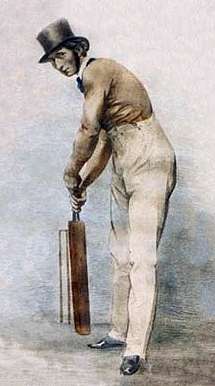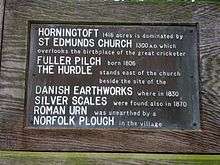Fuller Pilch
Fuller Pilch (17 March 1803 – 1 May 1870) was an English first-class cricketer. Described as "the greatest batsman ever known until the appearance of W. G. Grace",[2] the right-handed batsman Pilch played 229 first-class matches between 1820 and 1854 for an assortment of counties, including Kent, Hampshire, Surrey and Sussex, as well as Norfolk and Cambridge Town Club (aka Cambridgeshire). An early pioneer of batting, Pilch's advert of the "Pilch poke", or art of playing the ball forward, was an early manifestation of modern batting practices.[2]
 | |||||||||||||||||||||||||||
| Personal information | |||||||||||||||||||||||||||
|---|---|---|---|---|---|---|---|---|---|---|---|---|---|---|---|---|---|---|---|---|---|---|---|---|---|---|---|
| Full name | Fuller Pilch | ||||||||||||||||||||||||||
| Born | 17 March 1803 Horningtoft, Norfolk, England | ||||||||||||||||||||||||||
| Died | 1 May 1870 (aged 66) Canterbury, Kent, England | ||||||||||||||||||||||||||
| Height | 6 ft 1⁄2[1] in (1.84 m) | ||||||||||||||||||||||||||
| Batting | Right-handed | ||||||||||||||||||||||||||
| Bowling | Right arm slow (roundarm) | ||||||||||||||||||||||||||
| Domestic team information | |||||||||||||||||||||||||||
| Years | Team | ||||||||||||||||||||||||||
| 1836–1854 | Kent | ||||||||||||||||||||||||||
| 1830–1847 | Suffolk | ||||||||||||||||||||||||||
| 1842–1845 | Hampshire | ||||||||||||||||||||||||||
| 1831–1845 | Marylebone Cricket Club | ||||||||||||||||||||||||||
| 1830–1844 | Surrey | ||||||||||||||||||||||||||
| 1837–1842 | Sussex | ||||||||||||||||||||||||||
| 1820–1836 | Norfolk | ||||||||||||||||||||||||||
| Career statistics | |||||||||||||||||||||||||||
| |||||||||||||||||||||||||||
Source: Cricket Archive, 10 November 2009 | |||||||||||||||||||||||||||
Though his statistics reflect by modern standards as fairly ordinary, the ten centuries he amassed throughout his entire club and first-class playing career were considered "remarkable" in the context of round-arm bowling and poorly maintained cricket pitches encountered during the period.[2] He was also known for his success at single-wicket matches, defeating Tom Marsden in 1833.[3] He came from a cricketing family: nephew William Pilch and brothers Nathaniel and William all played first-class cricket.[2]
Early life
He was the son of Nathaniel Pilch and Frances Fuller, who were married at Brisley and later returned to live there. Fuller Pilch followed in the footsteps of his two elder brothers, Nathaniel and William, and became a professional cricketer. His first appearance at Lord's was a three-day match in July 1820, playing for Norfolk. He then went to Sheffield to play cricket and earn his living as a tailor.
Cricketing career
Writing in 1862 in his Scores and biographies, Arthur Haygarth called Pilch "the best batsman that has ever yet appeared". The main characteristic of Pilch's batting was his forward play, a shot that was called 'Pilch's poke'. Haygarth further wrote : "His style of batting was very commanding, extremely forward, and he seemed to rush to the best bowling by his long forward play before it had time to shoot or rise, or do mischief by catches".
By the late 1820s he had become the finest batsman in England and acquired the nickname, "the non pareil [unrivalled] hitter".[4] He appeared 23 times in Gentlemen v Players matches. In 1833, in highly publicised single wicket matches, he twice defeated Tom Marsden, the other prominent batsman of the time. In 1835, he moved to Town Malling in Kent and received a salary of 100 pounds a year. There he kept a tavern attached to the cricket ground.
Pilch moved to Canterbury in 1842 where he kept the Saracen's Head. He served as the first groundsman of the St. Lawrence Ground from 1847 to 1868.
As to the question of how Pilch would compare with the greatest of his successors, Wisden editor Sydney Pardon wrote in W. G. Grace's obituary in the 1916 Wisden :
A story is told of a cricketer who had regarded Fuller Pilch as the final word in batting, being taken in his old age to see Mr. Grace bat for the first time. He watched the great man for a quarter of an hour or so and then broke out into an expression of boundless delight. 'Why', he said, 'this man scores continuously from balls that old Fuller would have been thankful to stop'.
Pilch died at Canterbury in 1870. He never married.
Legacy

In June 2008 it was reported in The Times that Pilch's grave at St. Gregory's churchyard in Canterbury was preventing the development of the churchyard into a Canterbury Christ Church University concert hall, as it could not be located for removal.[5] In the following month, the grave was located through the use of an old photograph and the memories of local people.[6]
Pilch appears in the Flashman novel Flashman's Lady by George MacDonald Fraser. In the novel Pilch is caught and bowled by Flashman in a fictional game set at Lord's between Rugby Old Boys and Kent in 1842.
Fuller Pilch is mentioned in the song "Gentlemen and Players" on the 2009 cricket concept album The Duckworth Lewis Method, created by Irish duo Thomas Walsh and Neil Hannon.
References
- Samson. British Museum
- Brown, R. J. "Player Profile: Fuller Pilch". The Cricketer. CricInfo. Retrieved 10 November 2009.
- Martineau, G. D. (1963). "Single-wicket again". The Cricketer. CricInfo. Retrieved 10 November 2009.
- Gideon Haigh, 'Moniker Mania' in Wisden 2015 at p.46. William Lillywhite was known as "the non pareil bowler".
- The Times, 25 June 2008
- "Old picture solves grave mystery". British Broadcasting Corporation. 1 July 2008. Retrieved 2 July 2008.
External links

- Horningtoft Heritage Society Site
- Fuller Pilch at ESPNcricinfo